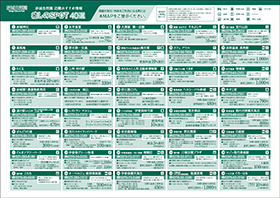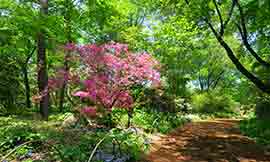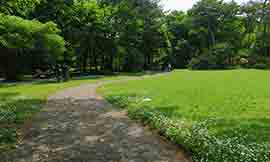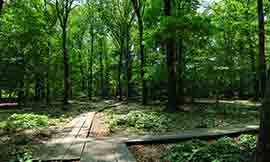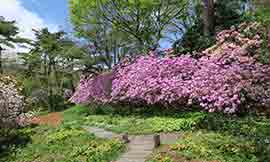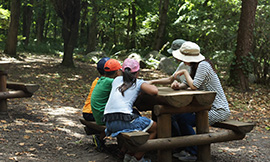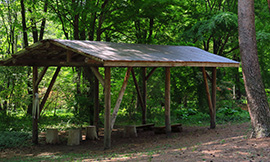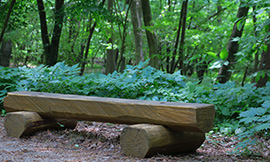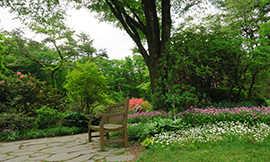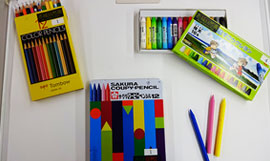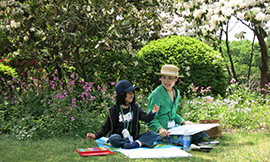撮影場所:道標19番 続きをみる
About the Akagi Nature Park
This is a forest where happiness grows.
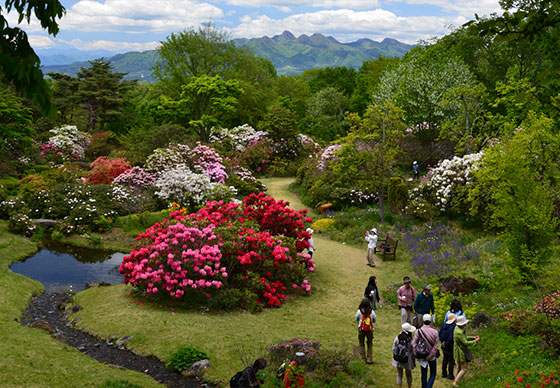
Akagi Nature Park is located at the foot of Mt. Akagi on the western side, at an elevation of 600 - 700 meters. Flowers bloom all over the park in spring, the whole area is brimming with life in the summer, and the trees turn to vibrant colors in the fall. The rich experience of the four seasons of Japan is interwoven into the forest, and you can truly experience the beauty of nature here.
With the goal of making coexistence between humanity and nature a reality, vegetation has been painstakingly replaced and substituted over a period of more than 30 years, continually working to create an environment with thriving plant life where insects and small animals can live comfortably. This park is now a place where visitors can observe a large number of plant and insect species native to the Kita-Kanto area in an environment very similar to their natural habitat.
Because maintenance is performed on the area, even the low-lying plants get plenty of light, and many species of wild grasses and flowers in danger of extinction grow in the park. Also, bark is used for the comfortable walking path on the trails, and the benches and chairs in the park are made from wood taken from thinning operations. Facilities for hand washing are available in the major areas of the park, so you can relax and take a leisurely stroll through the forest, admiring various plants, and observing the insects as you walk. In this forest, the flowers, trees, and visiting customers are all happy to be here.

Spring, Summer,
Early Fall, and Late FallVideo of Akagi Nature Park
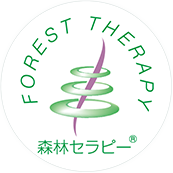
Akagi Nature Park is a certified forest therapy site.
Visiting the park has a relaxing effect that has been scientifically verified. This is called "forest therapy." Enjoying the forest leads to heightened comfort of mind and body, and increased recuperation. There are expectations that this relaxation effect can have beneficial effects for preventive medicine such as improving immune system function. Through physiopsychological studies, Akagi Nature Park has been certified as a forest therapy site.
Link to the Forest Therapy (click here for the Japanese page)
Management Philosophy
Preserving a lush forest for the children of the future.
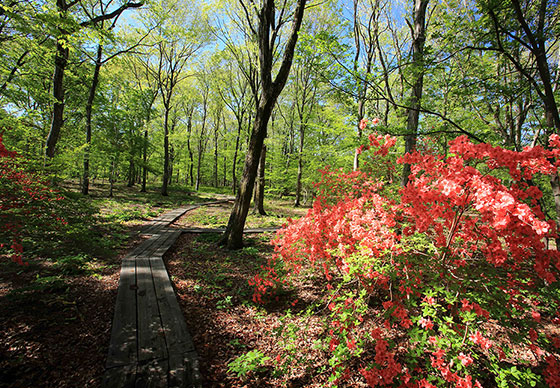
The flowers, the sound of the streams, and the fresh breezes blowing through the forest... everything is pure nature and full of life.
Approximately 30 years were spent preparing the environment, and the resulting regenerated forest is now Akagi Nature Park.
We hope this lush forest will be a place for play, laughter, new discoveries, learning and emotion. This is what all the park's staff members wish for.
In order to pass a lush forest on to the children who will bear the burdens of the next generation,
Credit Saison Co., Ltd. has been managing Akagi Nature Park since 2010 as one of its societal contribution activities.
In the 1980s, Seiji Tsutsumi of the Seibu Saison Group took on core leadership, and launched the 21st century project, "peaceful coexistence of human activities and nature." This forest was created with the goal of contributing to the development of civilian activities to spread the discovery and creation of nature in its various forms.
When Seiji Tsutsumi saw children seeing stag beetles and tadpoles for the first time on a department store rooftop, he was shocked.
Supposedly, this experience was the spark that drove him to create the forest.
"Instead of growing flowers, we will organize the proper environment to assist their growth naturally."
With the goal of creating an integrated nature observation park to provide comfortable and beautiful natural surroundings for the lives of the people, he spent 30 years taking a mixed forest that was initially composed of mostly pine and cedar trees and transforming it into a balanced environment where a variety of tree and flower species could thrive through transplantation.
In 2010, our company was given control of this forest's management. We have been conducting our management of the park with the support of a variety of individuals, businesses, and groups who agreed with our sentiment, "We want to contribute to a richer society by allowing as many children as possible to experience nature and develop their sensitivities."
History
- 1971:Seibu Urban Development Corporation (name later changed to The Seiyo Corporation) began acquiring properties for development of holiday houses, golf courses, etc., with the goal of developing resort areas.
- 1980:Combined the scattered properties to create a park area roughly identical to the present form.
- 1986:Clarified the intentions of Akagi Nature Park, and submitted a general plan to the government.
- 1987:Approved as a "partially protected forest preserve and designated protection forest for health."
- 1988:The Seiyo Corporation transferred the applicable property to The Seiyu Co., Ltd.
- 1990:The Seiyu Co., Ltd. (name later changed to Seiyu GK) purchased a portion of the land from local property holders, etc.
- 1993:Partial park openings conducted as a test to allow local people concerned to experience the park during the setup process.
- 2009:Managing company changed to Credit Saison Co., Ltd.
- 2010:Major increases in the number of days the park is open starting in April.
- 2014:Certified as a forest therapy site. More than 50,000 people visited the park this year.
- 2015:Over 200,000 visitors to the park since the new management took over in 2010.
About the Akagi Nature Park (click here for the Japanese page)
Park Opening Schedule
Park Schedule
April-November (Closed Tuesday,Open throughout May)
December-March (Opened on Saturday and Sunday, Except New Year Holidays)
Park Opening Hours
9:00 a.m. - 4:30 p.m. *No park entry after 3:30 p.m.
Park Entry Fees
General
| Adults | 1,000 yen |
|---|---|
| Children | Free (elementary school to junior high school age) |
| SAISONCARD and UCCARD holders: | 500 yen (rate for the cardholders only, not groups) |
- ・Parking is available free of charge. (400 parking spaces)
- ・For visitors with disability certificates or rehabilitation certificates, free entry is available for the certificate holder and one helper.
Click here to apply for a SAISONCARD
Groups
| Adults | 500 yen |
|---|---|
| Children | Free |
- ・For groups of 20 or more (adults and children) visiting the park together, the entry fees for adults are 500 yen per person, and children may enter the park free of charge.
Group reservations (click here for the Japanese page)
Yearly passports and supporter certificates
A supporter certificate will be issued to individuals with an understanding of the management operations of Akagi Nature Park who support our efforts. Individuals who become supporters will also be issued a passport that allows unlimited entry into the park for a one-year period so that they can enjoy all the beauty of the transitions between the four seasons in the park.
| Adults | 3,000yen |
|---|
- ・Unlimited entry into the park for a one-year period from the purchase of this passport.
Access and Information on the Surrounding Area
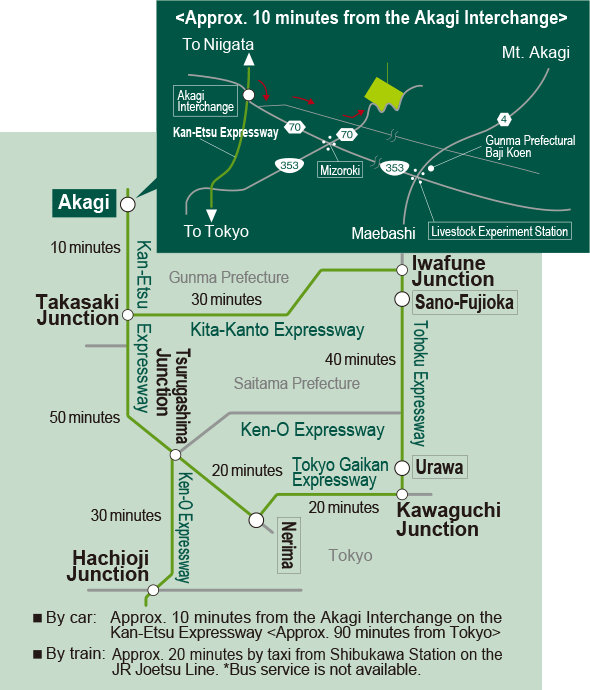
By car:
approx. 90 minutes from Tokyo
Take the Kan-Etsu Expressway from the Nerima Interchange to the Akagi Interchange (111.2 km, approx. 80 minutes). From the Akagi Interchange, Akagi Nature Park is 6.7 km away, about a 10-minute drive.
・The park is also about 90 minutes away by the following route: Tokyo to Tohoku Expressway → Kita-Kanto Expressway → Kan-Etsu Expressway.
By train:
Take the JR Joetsu Line from Ueno to Shibukawa (approx. 100 minutes by limited express train). From Shibukawa, Akagi Nature Park is about 20 minutes by taxi.
Additional route: Take the Joetsu Shinkansen from Ueno to Takasaki (approx. 55 minutes), then take the Joetsu Line from Takasaki to Shibukawa (approx. 25 minutes). From Shibukawa, Akagi Nature Park is about 20 minutes by taxi.
From April to November, shuttle bus that connects JR Shibukawa Station and Akagi Nature Park is operated.
Schedule: Sat. /Sun./Holydays from April to November
One way fares: Adult 600yen, Child 300yen
Timetable:
Departs from JR Shibukawa Station - Departure time 9:00, 10:10, 11:45
Departs from Akagi Nature Park - Departure time 10:50, 12:20, 14:10, 15:45
(Duration: about 20 mins)
Taking a taxi from JR Shibukawa Station
Gunhoku Daiichi Koutsu
・There is a special round-trip plan for customers traveling from Shibukawa Station and Akagi Nature Park. Please inquire with the company for details.
0120-50-2245
・1830-45 Shibukawa, Shibukawa-shi
・Open every day / 24-hour service
Day-trip bus tour
For more information about bus tours departing from Tokyo and various other areas, click here.
・Sightseeing around Akagi Nature Park: Relaxing Spots
In the area around Akagi Nature Park, there are many places where you can spend some time relaxing your mind and body, such as hot springs, restaurants, and leisure facilities. From the available spots, park staff have chosen their most-recommended locations, and the information for each one is recorded on this map.
By all means try out one of the nearby casual restaurants, Ikaho Hot Spring or some of Gunma Prefecture’s other famous hot springs, lodging facilities, or sightseeing spots before or after your visit to Akagi Nature Park.
Special bonuses are available at some of the locations as well if you print out this map and bring it with you! (Printed copies of this map are also available at Akagi Nature Park.)
Make the most of a day of leisure with a walk in the Akagi Nature Park, followed by a delicious meal, and concluding with a relaxing soak in an outdoor hot spring bath.
This information is also available in PDF format.
・Address
892 Minami Akagisan, Akagi-machi, Shibukawa-shi, Gunma-ken 379-1113
Phone: 0279-56-5211
Access and information on the surrounding area (click here for the Japanese page)
Map of Park, Facilities, Services
This is a peaceful forest where happiness grows.
The environment in the park has been specially created to support the growth of wild flowers. Wild birds fly over. Insects being populating the area. The ecosystem is completed, and the cycle of life continues as the forest achieves its natural state. Welcome to Akagi Nature Park. This is a healing forest that bring happiness to all who visit, whether they’re coming to see the trees or the flowers.
Akagi Nature Park is certified as a “forest therapy site” and the forests in the park have scientifically-proven healing qualities.
Forest therapy (click here for the Japanese page)
Map of the Park
Take a deep breath and let the forest air wash over you.
The part of the park currently open (approximately 60 hectares) is divided into three separate areas: “Saison Garden,” “Four Seasons Forest,” and “Natural Ecosystem Forest.” Different flora and fauna inhabit the three areas, giving each one its own unique characteristics. Walking around all three areas takes about two hours, and generally around 10,000 steps. Throughout the entire expansive park area, the maximum change in elevation is about 100 meters. The trail is laid with a bark path to make it comfortable for your feet, and wood paths that are easy to walk along are also available. Enjoy the palpable rhythm of nature’s slow transition from season to season to your heart’s content.
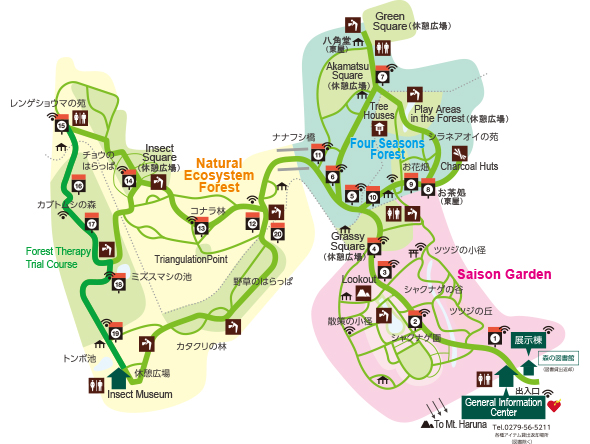

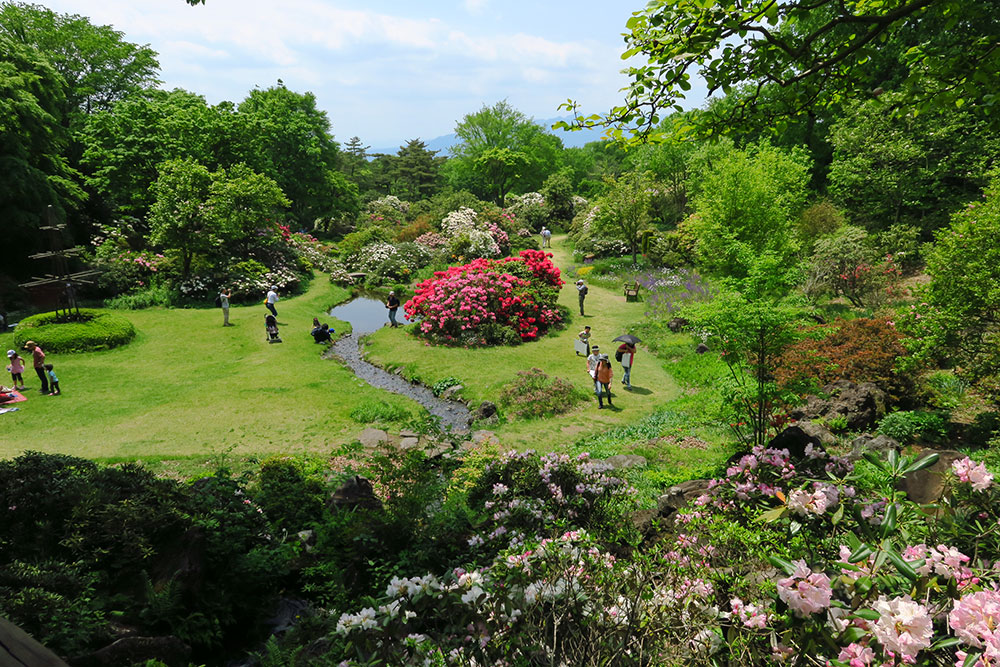
Saison Garden
Features an English garden with brilliant flowers like Western rhododendrons and Chinese peonies welcoming you, plus areas with a Japanese style of beauty to enjoy where wildflowers such as Akayashio rhododendrons and Azuma rhododendrons bloom gracefully.
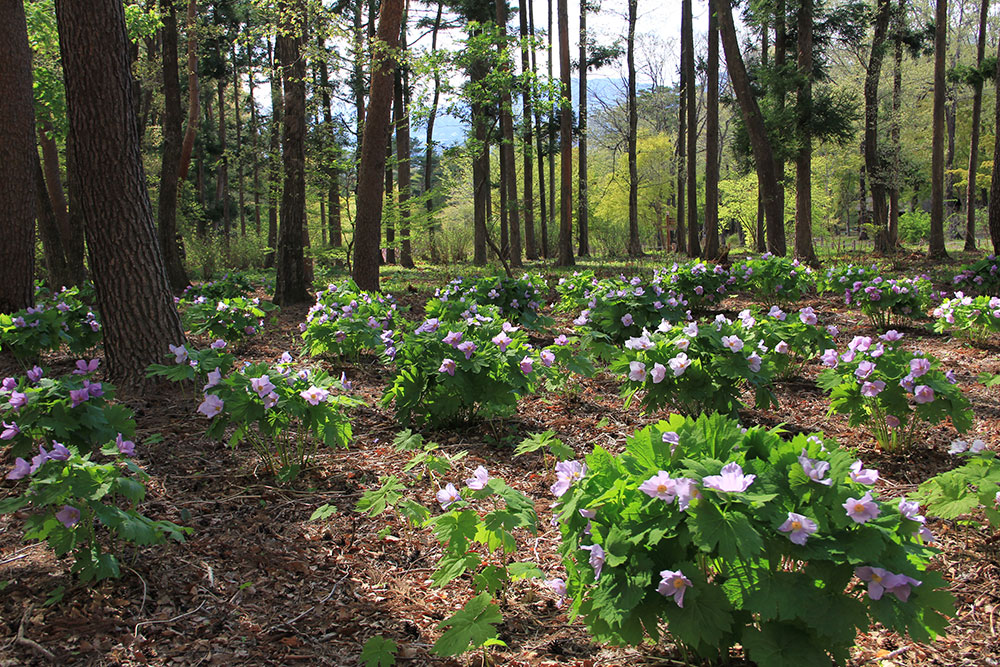
Four Seasons Forest
Glaucidium and other wild flowers and grasses grow and bloom in abundance, Japanese primrose colors the brooks, and there are little tree houses and other spots to play in the forest. This area is a place to relax and refresh yourself with nature all around you.
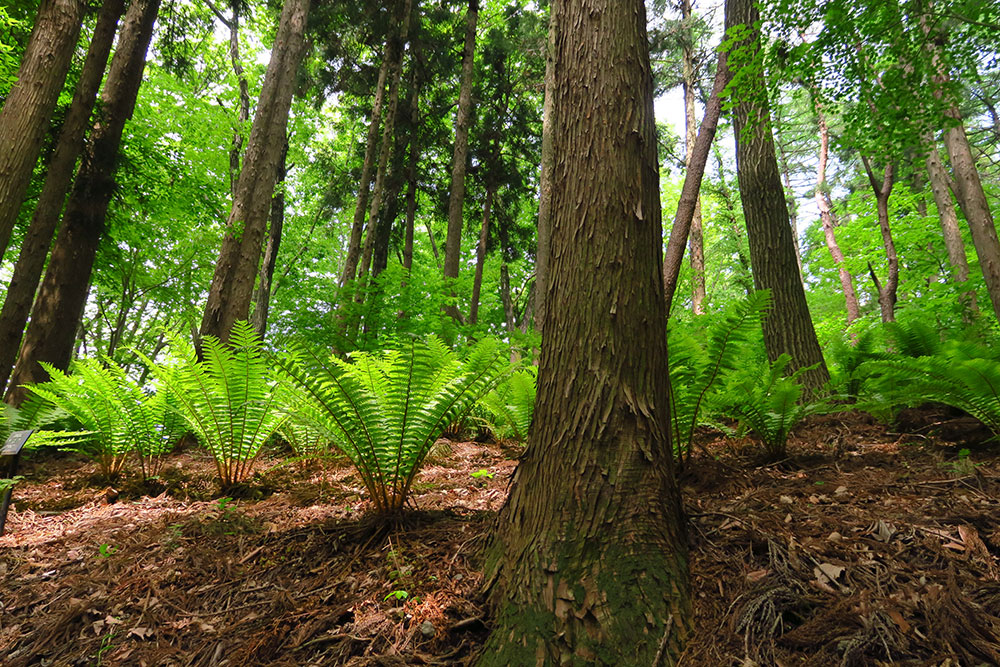
Natural Ecosystem Forest
Cross the Nanafushi Bridge, and you'll enter the Natural Ecosystem Forest. This forest area is thicker, and there are lots of exciting things to find in the ponds and open areas. You can observe the various creatures in their natural habitat.
Requests for Park Visitors
- ・To preserve the park environment, visitors may only use the walking trails and open areas for resting. Entrance to other areas of the park is prohibited.
- ・Collecting plants and animals is prohibited.
- ・Be careful not to disturb the bees.
- ・Drinking alcohol, smoking cigarettes, and lighting fires are all prohibited inside the park.
- ・Please only eat in the exhibition building, gazebo, or open areas for resting.
*There are no restaurants inside the park. (Please bring your own food.)
Vending machines selling drinks are available in the exhibition building. - ・Please take your trash home with you.
- ・Pets are not allowed in the park.
*However, visitors with assistance dogs may enter the park accompanied by their animals.
| Bathrooms | |
| Hand-Washing Locations | |
| Charcoal Huts: Making charcoal from trees grown in the park. |
|
| Tree Houses: Popular spot for playing in the forest. |
|
| Lookout: Gives an expansive view of the rhododendron gardens, and on a clear day, you can see as far as Mt. Haruna. |
| Gazebo | |
| Trails and Wooden Paths | |
| Entering the road for maintenance vehicles (asphalt-paved road) is prohibited. | |
| The numbers on the map represent the location of the signposts. Walking around the entire park takes about two hours. | |
| Information Areas | |
| AED equipment location (General Information Center) |
General Information about Akagi Nature Park
| Area | Approx. 120 hectares (or about 360,000 tsubo). Area open to the public: Approx. 60 hectares (or about 180,000 tsubo). |
|---|---|
| Elevation | 600 - 700 meters |
| Location | Foot of Mt. Akagi (west side) |
Confirmed species in Akagi Nature Park
| Animals | 1,810 species of insects, 77 species of birds, 15 species of mammals. |
|---|---|
| Plants | 152 species of trees, 510 species of herbs |
Information about the Park Interior
Enjoy the changes as the natural surroundings transition from season to season.
Inside the park, wild grasses, trees, and shrubs are thriving. In order to help visitors experience a variety of new meetings and discoveries, signs and other manmade structures are kept to the bare minimum within the park. Please enjoy our peaceful and relaxing forest to your heart’s content.
Saison Garden
-
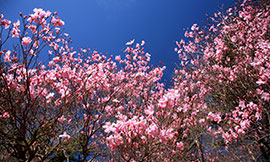
Azalea Hill
Beautiful blooms of flowers such as pink, white, and honeywort varieties of azaleas bring lush color to the area.
-
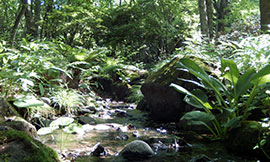
Rhododendron Valley
Azuma rhododendrons bring color and clean, clear water flows through this valley. Listen to the trickle of the stream as you enjoy a walk in the forest.
-
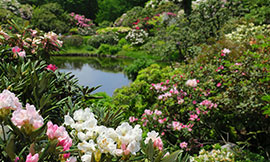
Rhododendron Garden
A rich variety of rhododendrons are in bloom here, and it's one of the largest rhododendron gardens in East Asia.
-
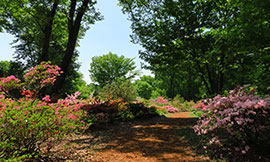
Walking Path
This path runs through the forest with good visibility, with views of a rich variety of azaleas blooming nearby.
-
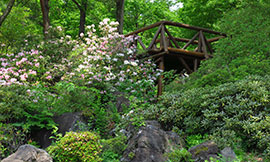
Lookout
Provides an expansive view of the rhododendron garden, and you can even see Mt. Haruna on a clear day.
-
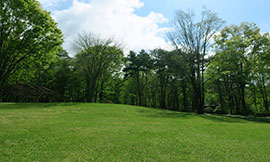
Grassy Square (open area for resting)
This is the first rest area. It's a popular spot for opening up a bento and enjoying a meal, either down on the grass or up on one of the wooden tables.
-
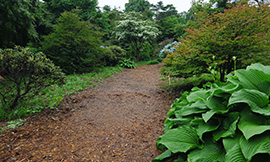
Azalea Path
This walking path is colored by relatively short azalea flowers.
Four Seasons Forest
-
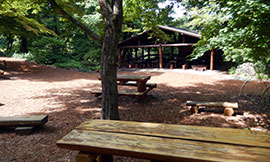
Tea Spot (Gazebo)
Around 40 people can fit in this gazebo at once. It's an ideal spot for eating lunch on a rainy day.
-
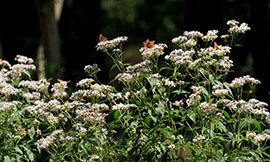
Flower Garden
From summer to fall, flowers such as fireweed, balloon flowers, Veronicastrum wildflowers, and thoroughwort fill this flower garden with color. This is also a marking location for chestnut tiger butterflies.
-
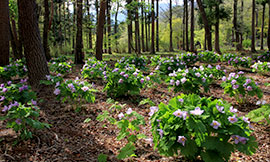
Glaucidium Palmatum Garden
This species is native to Japan, and the sight of the queen of wild grasses (a nickname for Glaucidium palmatum) covering the ground in a solid carpet is a must-see (this happens from late April to early May).
-
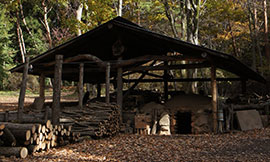
Charcoal Huts
Lumber taken from forest-thinning operations within the park is hardened into charcoal using traditional techniques. Lessons in charcoal sack making are also held on an irregular basis.
-
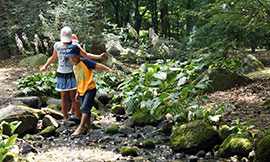
Play Areas in the Forest (open area for resting)
This area features tree houses and small streams to play in. It's popular with children.
-
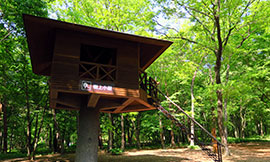
Tree Houses
These are the symbol for the play area in the forest. A tree house is like a secret fort where you can get a thrill of adventure. Please climb up and see for yourself.
-
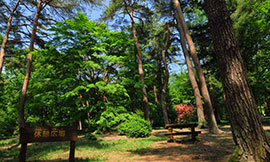
Akamatsu Square (open area for resting)
Tables and chairs are set up in a primeval forest of Japanese red pine trees. It's a great spot to enjoy the sight of blooming Oyama Magnolias in the spring and the changing colors of the maple leaves in the fall.
-
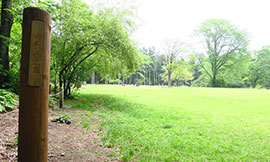
Green Square (open area for resting)
This open area is covered in lush grass. If you'd like to do some running or play ball games, this is the place. The grass is also a nice place to lie down for a nap.
-
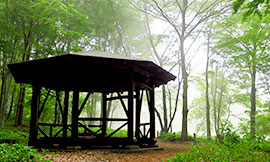
Octagon Building (Gazebo)
You can relax and take your time in this gazebo. There are walnut trees nearby, so you often see walnuts that squirrels have chewed on in this area.
Natural Ecosystem Forest
-
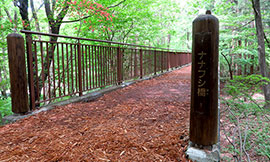
Walking Stick Bridge
This bridge is set up in the middle of the public area of the park, and when you walk across you'll arrive in the Natural Ecosystem Forest, which has a totally different atmosphere. The bridge takes its name from walking stick insects.
-
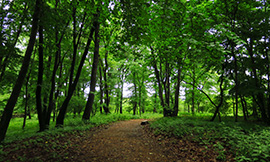
Konara Oak Forest
Just the right amount of light gets in, and this forest is full of thriving konara oak trees and other plant life. This is the perfect spot to take a deep breath and let nature sink in.
-
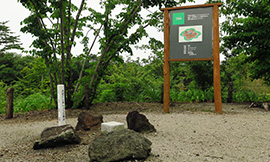
Triangulation Point
As the name suggests, this is a reference point for surveying. The elevation is 675 meters above sea level.
-
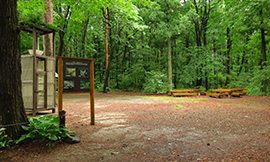
Insect Square (open area for resting)
There are various specimens here such as insect traps and beehives. Tables and chairs are also set up, so you can take some time to relax.
-
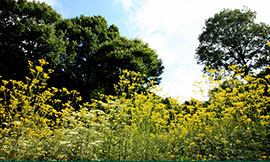
Butterfly Field
This is the best place to enjoy the seven major flowers of autumn such as golden lace, gillyflowers, clovers, and thoroughwort. Chestnut tiger butterflies are also marked in this area.
-
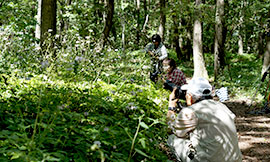
False Anemone Garden
This area is the highest elevation in the park, and forest sprites (another name for false anemone flowers) grow along the road for a stretch of about 100 meters. Enjoy the refreshing breeze that often blows through the park here.
-
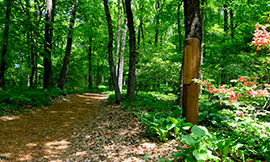
Japanese Rhinoceros Beetle Forest
There are lots of trees like sawtooth and konara oaks that Japanese rhinoceros beetles love. Maybe you'll see one if you come here?
-
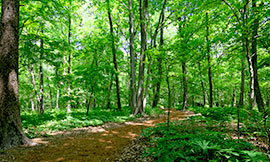
Forest Therapy Trial Course
An experiment measuring the effects of treatment was carried out on this route. The recommended route goes from signpost 15 to the Insect Museum, with lots of trees all around and a gentle slope. It's an extremely effective course for forest therapy.
-
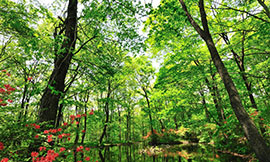
Whirligig Beetle Pond
Whirligig beetles spin around and around, drawing circles on the water surface. Fireflies also live in this pond area, so go for a night hike in the summer if you'd like to see them.
-
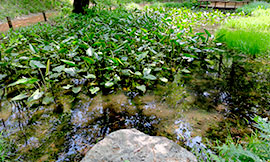
Dragonfly Pond
Yellow water lilies bloom here in the spring, and as the name suggests, there are lots of dragonflies flying around from summer to fall. There's also a space where you can observe what's happening beneath the surface of the pond.
-
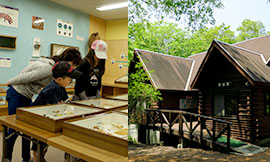
Insect Museum
With a focus on insect specimens from inside Akagi Nature Park, this facility shares information about the lives of these little creatures. It's a perfect spot for an independent research project over summer vacation.
-
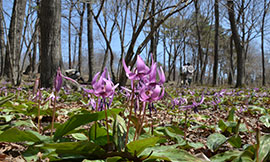
Dogtooth Violet Woods
In early spring, Coptis japonica flowers bloom, and afterward nearly 50,000 cultivated dogtooth violets bloom and cover the area. When all the flowers are blooming in April, the solid violet carpet covering the ground is a beautiful sight.
-
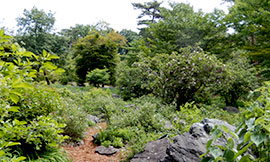
Field of Wild Grasses
As the name suggests, there are lots of wild grasses here. There are also a number of large rocks set up in this area, providing a comfortable habitat for insects and reptiles.
-
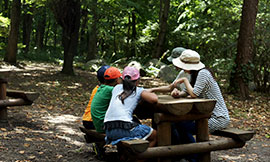
open area for resting (in front of the Insect Museum)
There are tables and chairs set up in this open rest area in front of the Insect Museum. This rest area is set up deeper in the park than any of the others. Relax and take it easy here.
Facilities and Services
A forest that everyone can enjoy with peace of mind.
Our facilities are designed so that everyone from small children to elderly visitors can relax and enjoy themselves.
General Information Center
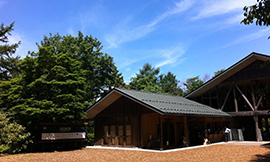
Entrance to the park, lending and returns of various items, and various customer inquiries are handled here.
Phone: 0279-56-5211
Items that can be checked out on loan:
1
- ・Motor-assisted wheelchairs
- ・Wheelchairs (manual)
- ・Items to help you enjoy the forest
- ・Forest atelier (materials for sketching and drawing are available)
- ・Lunchboxes (by reservation)
*AED equipment location
Exhibition Building
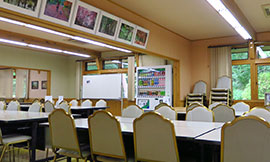
Items such as a diorama of the Akagi Nature Park and winning entries to photo contests are displayed here. In addition, “The Four Seasons of Akagi Nature Park,” a piece shot by photographer Yukihito Arai, is available for viewing here. There are also rest areas here that can be used freely by all visitors. Vending machines for drinks are available.
Trails and Wooden Paths
A path is laid in bark, using natural materials to make walking easy on your feet and soften the slopes. Visitors in wheelchairs and bring strollers can also enter the park. In order to protect the park environment, visitors are prohibited from entering any areas other than the trails, wooden paths, and open areas for resting. * The asphalt-paved road is for maintenance vehicles only, so entering this area is also prohibited.
Signposts and Maps
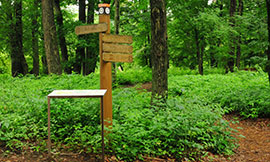
Signposts are located in positions 1 - 20. There are maps of the park facilities located near the majority of these signposts, and your current location is displayed on each of them.
Bathrooms
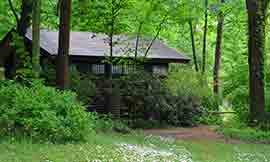
There are a total of five bathroom facilities in the park.
*Diaper changing tables are only available in the bathrooms next to the General Information Center.
Hand-Washing Locations
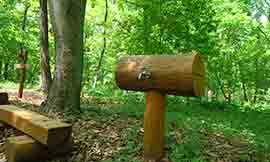
These facilities are set up in the major areas of the park. They use a groundwater supply pulled from approximately 280 meters underground.
Open Areas for Resting, Gazebo
There are six open areas for resting, and nine gazebo locations inside the park. Please only eat in these areas when you are visiting the park.
Benches
In the Saison Garden, comfortable British benches are set up for your use. Benches made from wood taken from thinning operations are also set up in various places inside the forest. The height of these benches is designed such that when you sit, the wild flowers are right at eye level. Please sit down and see for yourself.
Akagi Nature Park “Hana Goyomi App”
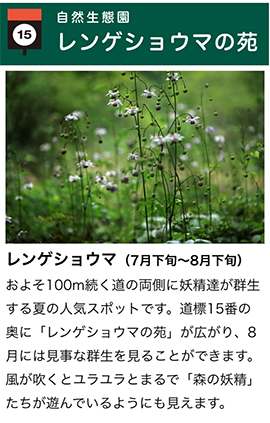
If you download either the “Saison Portal” app or the “UC Portal” app, when you get close to an information area (mark), information about seasonal conditions and the flowers in that area will be sent to your device. (Links for “Saison Portal” and “UC Portal.”)
Motor-assisted Wheelchairs for Visitors
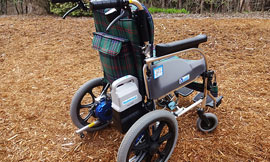
You’ll have no trouble getting up the steeper areas. Electric-powered wheelchairs that provide an assistive function to support your manual power are available for rental. (Reservation required. Charges apply.)
*Depending on the weather and the conditions of the trails, these wheelchairs may not be available for use in some cases.
*Please inquire at the General Information Center for details.
Wheelchairs (Manual) for Visitors
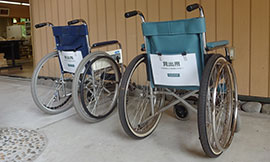
Manual wheelchairs are available on loan free of charge.
Lending Service for Items to Enjoy the Forest (General Information Center)
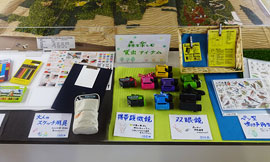
A variety of items to make the forest even more fun through activities like wild bird and insect observation, such as binoculars and portable microscopes, are available for lending here. Please try some of them out for yourself!
Forest Atelier (Sketching and Drawing Supplies are Available at the General Information Center)
An atelier in the middle of the forest to use freely. Watercolor pencils and crayons are available on loan. How about making a picture postcard featuring the forest or some flowers to send to someone special? Drawing boards for children are also available.
*Fees apply for some items. Please inquire at the General Information Center for details.
Lunchbox Reservation Service (for 10 or more lunches)
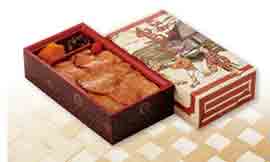
Delivery services for lunchboxes from “Torihei,” a chicken and rice restaurant that is loved by people in the Joshu area, are available for groups of 10 or more. Choose any of five different types of popular chicken and rice lunchboxes. Please send in your application by 1:00 p.m. the day before your visit at this link: group reservation application.
Forest Library
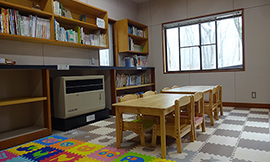
Approximately 300 books are available, and can be checked out free of charge (mainly children’s picture books, books for young readers, and plant reference books). You can take them out with you into the forest, so how about having a seat in the comfortable or one of our benches, and stopping to read for a bit?
Souvenir Shop
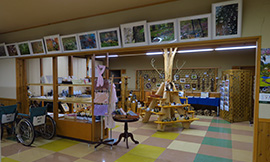
Selling original Akagi Nature Park goods in response to overwhelming customer demand, with products such as charcoal sacks, wood vinegar, canes, and wooden benches. Locally-made Gunma Prefecture souvenirs, illustrated stationery of wild grasses, snacks (bread), and candy are also available. Please stop by on your visit.
Map of the park, facilities, and services (click here for the Japanese page)





